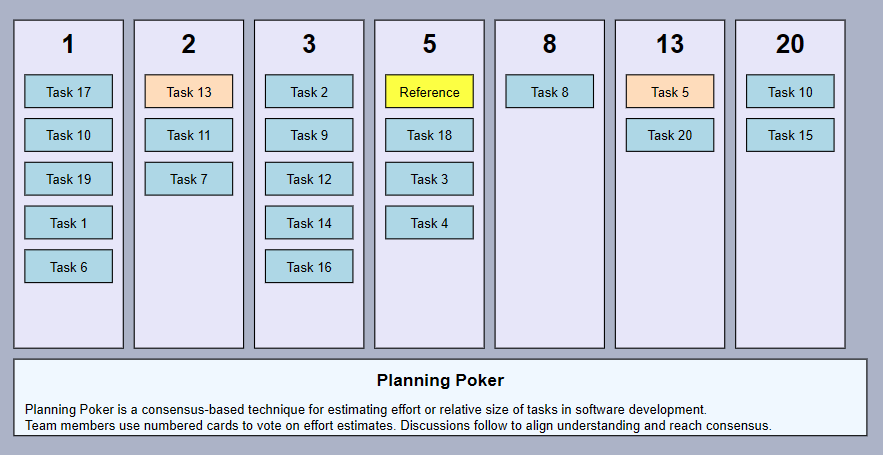Table of Contents
1 Understanding Story Points in Scrum: A Comprehensive Guide
In the realm of agile project management, particularly within the Scrum framework, the concept of story points has emerged as a pivotal element for estimating the effort required to complete a user story. This article delves deeply into what story points are, their significance in Scrum, and best practices for their effective utilization. We will explore various aspects of story points, including their calculation, the rationale behind their use, common misconceptions, and practical applications in real-world scenarios.
1.1 Introduction to Story Points
Story points are a unit of measure used in agile methodologies to estimate the relative effort required to implement a user story. Unlike traditional estimation methods that rely on time-based metrics (e. g. , hours or days), story points abstract the estimation process by considering several factors such as complexity, risk, and effort. This approach allows teams to gauge the workload without tying it directly to a specific timeframe, thus promoting flexibility and adaptability in project planning.
The Agile Manifesto, introduced in 2001, emphasized the importance of responding to change over following a fixed plan. As Agile practices evolved, teams sought more effective ways to estimate work that aligned with Agile principles. This led to the adoption of story points, which provide a more nuanced perspective on work estimation.
- Relative Estimation: Story points facilitate relative estimation, allowing teams to compare the complexity of different tasks.
- Focus on Team Velocity: By estimating in story points, teams can measure their velocity (the number of story points completed in a sprint), helping in future sprint planning.
- Encourages Collaboration: Estimating story points typically involves the entire team, fostering collaboration and shared understanding of the work involved.
- Promotes Continuous Improvement: Teams can track their performance over time, using historical data to refine their estimation techniques.
1.2 The Mechanics of Story Points
Story points are typically defined using a Fibonacci sequence (1, 2, 3, 5, 8, 13, etc. ) or similar progression (e. g. , powers of two). This sequence allows teams to express uncertainty and complexity without getting bogged down in minutiae.
| story point | Description |
|————-|———————–|
| 1 | Very simple task |
| 2 | Simple task |
| 3 | Moderate complexity |
| 5 | Complex task |
| 8 | Very complex task |
| 13 | Highly complex task |
Several techniques can be employed to estimate story points effectively:
Planning Poker is a consensus-based technique where team members independently select a card representing their estimate for a user story. After revealing their estimates, the team discusses discrepancies to reach a consensus.
This method categorizes user stories into sizes (XS, S, M, L, XL) that correspond to story points. While less precise, it provides a quick way to gauge complexity.
In this approach, user stories are grouped based on their complexity and effort. Teams can then assign story points to groups rather than individual stories, speeding up the estimation process.
Velocity is a key metric in Scrum, representing the average number of story points completed in a sprint. Understanding velocity helps teams in sprint planning and forecasting future work.
1. Record Completed Story Points: At the end of each sprint, tally the story points for all completed user stories.
2. Average Over Sprints: Calculate the average over several sprints to smooth out fluctuations.
| Sprint | Completed Story Points |
|——–|————————|
| 1 | 20 |
| 2 | 25 |
| 3 | 22 |
| 4 | 30 |
| Average Velocity | 24 |
1.3 Common Misconceptions About Story Points
Despite their widespread use, story points are often misunderstood. Here are some common misconceptions:
One of the most significant misconceptions is that story points correlate directly to time. In reality, story points reflect the complexity and uncertainty of a task rather than the hours it will take to complete.
Story points are relative to each team’s velocity and understanding of complexity. A user story estimated at 5 points by one team may be rated differently by another team, depending on their experience and context.
While higher story points indicate increased complexity, they do not necessarily denote a longer duration. A team may complete a 13-point task faster than a 5-point task if they are more familiar with the complexities involved.
1.4 Practical Applications of Story Points in Real-World Scenarios

Now, let me provide a brief explanation about planning poker and how to use it for Scrum story points:
Planning Poker is a consensus-based estimation technique commonly used in Agile and Scrum methodologies to assign story points to user stories or tasks. Here’s how it works and why it’s useful:
- Process:
- The product owner or scrum master presents a user story to the team.
- Each team member has a deck of cards with values representing story points (usually Fibonacci sequence: 1, 2, 3, 5, 8, 13, 20, etc.).
- After discussing the story, each member secretly selects a card representing their estimate.
- All cards are revealed simultaneously.
- If there’s a significant discrepancy, team members discuss their reasoning.
- The process is repeated until consensus is reached.
- Benefits:
- Encourages team participation and leverages collective wisdom.
- Reduces the influence of dominant personalities.
- Promotes discussion and shared understanding of requirements.
- Helps identify misunderstandings or missing information early.
- Using Planning Poker for Scrum Story Points:
- Story points represent relative effort, complexity, and uncertainty.
- The team should agree on a “reference story” as a baseline (e.g., a 5-point story).
- Estimate other stories in relation to the reference story.
- Use the Planning Poker process to assign points to each story in the backlog.
- Over time, the team’s velocity (points completed per sprint) becomes clearer, aiding in sprint planning and forecasting.
- Tips:
- Focus on relative sizing rather than exact time estimates.
- Include the entire cross-functional team in the estimation process.
- Re-estimate if requirements change significantly.
- Use Planning Poker regularly to maintain consistent estimations.
By using Planning Poker for story point estimation, Scrum teams can improve their estimation accuracy, foster better communication, and create more realistic sprint plans.
1.5 Best Practices for Using Story Points
Engaging the entire team in estimation fosters shared understanding and buy-in. It also leverages diverse perspectives, improving estimation accuracy.
Avoid overcomplicating the estimation process. Use straightforward techniques and maintain a focus on relative complexity rather than absolute precision.
Regularly review your estimation process and adjust as necessary. Teams should be willing to refine their approach based on past performance and evolving team dynamics.
Encourage a culture of learning from past sprints. If estimates are consistently off, analyze the reasons and adjust future estimations accordingly.
1.6 Conclusion
Story points serve as a crucial tool in the Scrum framework, enabling teams to estimate work more effectively and adaptively. By focusing on relative complexity rather than time, story points help teams foster collaboration, enhance performance, and improve planning accuracy.
As Agile methodologies continue to evolve, the understanding and application of story points are likely to adapt as well. Future developments may include more sophisticated tools and techniques for estimation, possibly leveraging artificial intelligence to analyze historical data and provide insights.
In summary, mastering story points not only enhances the Scrum process but also empowers teams to deliver high-quality software incrementally, aligning closely with Agile principles of flexibility and responsiveness to change.
- Story points are a relative measure of effort, complexity, and risk.
- They promote team collaboration and continuous improvement.
- Understanding velocity helps in effective sprint and release planning.
- Best practices include involving the team, keeping the process simple, and adapting based on feedback.
By embracing the principles of story points, teams can enhance their Agile practices and drive successful project outcomes in an increasingly complex software development landscape.
Latest Articles
- What Does Lead Time Mean? A Guide for Professionals – September 23, 2024
- Mastering Agile Definition of Done: Key Principles Explained – September 23, 2024
- Understanding a Typical scrum master Job Description Explained – September 21, 2024
- Understand What is Lead Time in Kanban for Better Efficiency – September 21, 2024
- understanding agile Ceremonies: what are They and Why They matter – September 20, 2024

